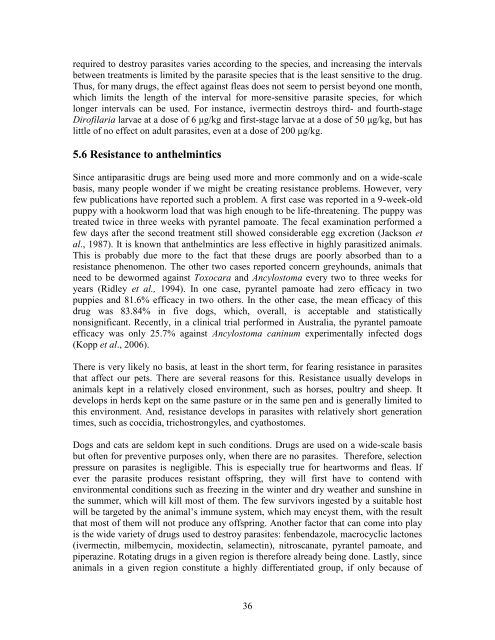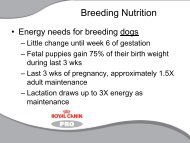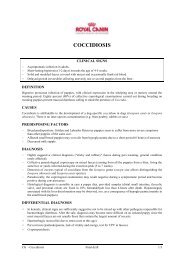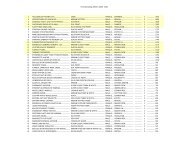Guide to Preventing Parasites.pdf - Royal Canin Canada
Guide to Preventing Parasites.pdf - Royal Canin Canada
Guide to Preventing Parasites.pdf - Royal Canin Canada
Create successful ePaper yourself
Turn your PDF publications into a flip-book with our unique Google optimized e-Paper software.
equired <strong>to</strong> destroy parasites varies according <strong>to</strong> the species, and increasing the intervals<br />
between treatments is limited by the parasite species that is the least sensitive <strong>to</strong> the drug.<br />
Thus, for many drugs, the effect against fleas does not seem <strong>to</strong> persist beyond one month,<br />
which limits the length of the interval for more-sensitive parasite species, for which<br />
longer intervals can be used. For instance, ivermectin destroys third- and fourth-stage<br />
Dirofilaria larvae at a dose of 6 μg/kg and first-stage larvae at a dose of 50 μg/kg, but has<br />
little of no effect on adult parasites, even at a dose of 200 μg/kg.<br />
5.6 Resistance <strong>to</strong> anthelmintics<br />
Since antiparasitic drugs are being used more and more commonly and on a wide-scale<br />
basis, many people wonder if we might be creating resistance problems. However, very<br />
few publications have reported such a problem. A first case was reported in a 9-week-old<br />
puppy with a hookworm load that was high enough <strong>to</strong> be life-threatening. The puppy was<br />
treated twice in three weeks with pyrantel pamoate. The fecal examination performed a<br />
few days after the second treatment still showed considerable egg excretion (Jackson et<br />
al., 1987). It is known that anthelmintics are less effective in highly parasitized animals.<br />
This is probably due more <strong>to</strong> the fact that these drugs are poorly absorbed than <strong>to</strong> a<br />
resistance phenomenon. The other two cases reported concern greyhounds, animals that<br />
need <strong>to</strong> be dewormed against Toxocara and Ancylos<strong>to</strong>ma every two <strong>to</strong> three weeks for<br />
years (Ridley et al., 1994). In one case, pyrantel pamoate had zero efficacy in two<br />
puppies and 81.6% efficacy in two others. In the other case, the mean efficacy of this<br />
drug was 83.84% in five dogs, which, overall, is acceptable and statistically<br />
nonsignificant. Recently, in a clinical trial performed in Australia, the pyrantel pamoate<br />
efficacy was only 25.7% against Ancylos<strong>to</strong>ma caninum experimentally infected dogs<br />
(Kopp et al., 2006).<br />
There is very likely no basis, at least in the short term, for fearing resistance in parasites<br />
that affect our pets. There are several reasons for this. Resistance usually develops in<br />
animals kept in a relatively closed environment, such as horses, poultry and sheep. It<br />
develops in herds kept on the same pasture or in the same pen and is generally limited <strong>to</strong><br />
this environment. And, resistance develops in parasites with relatively short generation<br />
times, such as coccidia, trichostrongyles, and cyathos<strong>to</strong>mes.<br />
Dogs and cats are seldom kept in such conditions. Drugs are used on a wide-scale basis<br />
but often for preventive purposes only, when there are no parasites. Therefore, selection<br />
pressure on parasites is negligible. This is especially true for heartworms and fleas. If<br />
ever the parasite produces resistant offspring, they will first have <strong>to</strong> contend with<br />
environmental conditions such as freezing in the winter and dry weather and sunshine in<br />
the summer, which will kill most of them. The few survivors ingested by a suitable host<br />
will be targeted by the animal’s immune system, which may encyst them, with the result<br />
that most of them will not produce any offspring. Another fac<strong>to</strong>r that can come in<strong>to</strong> play<br />
is the wide variety of drugs used <strong>to</strong> destroy parasites: fenbendazole, macrocyclic lac<strong>to</strong>nes<br />
(ivermectin, milbemycin, moxidectin, selamectin), nitroscanate, pyrantel pamoate, and<br />
piperazine. Rotating drugs in a given region is therefore already being done. Lastly, since<br />
animals in a given region constitute a highly differentiated group, if only because of<br />
36







